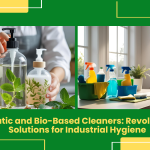Eco-Friendly Cleaners have emerged as a response to growing concerns over environmental pollution, human health risks, and the limitations of traditional cleaning agents. In this comprehensive guide, we explore the core problems posed by conventional detergents and disinfectants, the science-backed solutions offered by eco-friendly formulations, and practical prevention tips to minimize your environmental footprint while maintaining a spotless space. Along the way, we’ll highlight how Ecochem’s digital signage integrations can streamline your cleaning protocols, display real-time safety data, and connect over 100 applications for hassle-free facility management.
Problems with Traditional Cleaning Agents
Health and Environmental Hazards
Traditional cleaning agents often rely on synthetic surfactants, phosphates, and harsh solvents, which can linger in wastewater and aquatic ecosystems, harming wildlife and contributing to eutrophication. Many contain volatile organic compounds (VOCs) that release irritants into indoor air, triggering asthma, allergies, and other respiratory issues in occupants. In addition, residues of quaternary ammonium compounds (“quats”) in disinfectants may cause skin irritation and disrupt natural microbial communities on surfaces, potentially leading to disinfectant-resistant pathogens.
Limited Biodegradability
Synthetic detergents derived from petroleum are notoriously slow to biodegrade. When discharged into waterways, they form foams that prevent oxygen transfer, endangering aquatic life and altering ecosystems. Non-biodegradable components accumulate in sludge and sediments, persisting for years and bioaccumulating in the food chain.
Inefficient Cleaning Under Mild Conditions
Traditional cleaners often require high temperatures, strong alkalinity, or abrasive action to remove tough soils. This translates to increased energy consumption (hot water), accelerated wear on fabrics and finishes, and greater mechanical effort. Such harsh conditions also degrade delicate surfaces like stainless steel or natural stone, shortening equipment lifespan.
Solutions: The Science Behind Eco-Friendly Cleaners
Surfactants from Renewable Sources
At the heart of most Eco-Friendly Cleaners are biosurfactants—surface-active agents derived from plant oils, corn, or microbial fermentation. Unlike petroleum-based surfactants, biosurfactants reduce surface tension of water, emulsify oils, and lift dirt particles effectively while being readily biodegradable.
- Anionic Biosurfactants: Plant-derived fatty acid salts that excel in removing particulate soils in both soft and hard water conditions.
- Nonionic Biosurfactants: Ethoxylated plant alcohols that emulsify oils without forming excessive foam, ideal for low-rinse formulations.
- Amphoteric Biosurfactants: Derived from amino acids or betaines, these adapt to different pH levels, providing mild yet effective cleaning suited for skin-safe hand soaps and gentle surface cleaners.
Enzymatic Action for Targeted Soil Removal
Enzyme-enhanced Eco-Friendly Cleaners leverage biological catalysts—proteases, lipases, amylases, and cellulases—to break down complex organic stains at a molecular level. Proteases cleave protein stains (blood, food residue), lipases target fats and oils, and amylases tackle carbohydrate-based soils. Because enzymes are highly selective, they function optimally under mild pH and temperature, reducing energy use (cold-water efficacy) and extending the life of fabrics and surfaces .
pH Management for Surface Compatibility
Eco-Friendly Cleaners are formulated with near-neutral pH or mild acidity/alkalinity tailored to specific applications—neutral for multi-surface general cleaning, acidic for lime scale removal, and mild alkaline for grease emulsification. This targeted pH control minimizes damage to sensitive materials (e.g., natural stone, wood) and reduces the need for corrosive ingredients that can harm users and equipment Strathcona Cleaners.
Plant-Based Solvents and Essential Oils
Instead of petroleum solvents, many Eco-Friendly Cleaners incorporate plant-based solvents like d-limonene (citrus extract) or methyl soyate, which dissolve heavy greases and adhesives while remaining biodegradable and low-toxicity ECOS®. Essential oils (tea tree, lavender) not only impart natural fragrance but also contribute mild antimicrobial properties, reducing reliance on synthetic biocides.
Phosphate-Free and Chelator Alternatives
Phosphates, once ubiquitous for water softening and scale prevention, are now avoided in Eco-Friendly Cleaners due to their eutrophication potential. Instead, chelating agents like sodium gluconate or EDDS (ethylene-diamine-N,N′-disuccinate) sequester metal ions without promoting algal blooms .
Microbial Biosurfactants
Cutting-edge formulations include biosurfactants produced by bacteria or fungi (rhamnolipids, sophorolipids) that offer superior biodegradability and low toxicity. These microbial surfactants can self-assemble into micelles, capturing oils even at low concentrations, and break down fully in wastewater treatment processes .
Why Eco-Friendly Cleaners Matter
Protecting Human Health
By avoiding irritants, VOCs, and endocrine-disrupting chemicals, Eco-Friendly Cleaners reduce indoor air pollution and dermal exposure risks for building occupants and cleaning staff Strathcona Cleaners. Enzyme formulations often allow cold-water operations, minimizing thermal hazards and energy costs .
Safeguarding the Environment
Biodegradable ingredients ensure minimal persistence in waterways, preventing foam formation, oxygen depletion, and toxic buildup in sediments. Phosphate-free formulas curb algal blooms, while plant-derived solvents reduce reliance on finite fossil resources Cleaning.
Compliance and Corporate Responsibility
Many regulatory bodies, including the EPA’s Safer Choice program, recognize Eco-Friendly Cleaners that meet stringent human health and environmental criteria. Organizations adopting these products demonstrate commitment to sustainability goals, ESG frameworks, and green building certifications like LEED or BREEAM .
Prevention Tips: Maximizing Eco-Friendly Cleaning Practices
1. Pre-Soak and Pre-Treat
Apply enzyme-based pre-treatments to heavily soiled surfaces or textiles to reduce overall detergent load. Pre-soaking in cool water with mild enzyme cleaner can cut cleaning time and chemical concentration infinita.
2. Optimize Application Methods
Use microfiber cloths and low-pressure spray systems to distribute Eco-Friendly Cleaners evenly, minimizing waste and ensuring adequate contact time for enzymes and surfactants to act American Cleaning Institute.
3. Temperature and pH Control
Select formulations matched to the cleaning task—neutral cleaners for daily maintenance, acidic ones for mineral deposits, and alkaline products for grease removal. Wherever possible, operate at ambient or cold temperatures to save energy and preserve enzyme activity Strathcona Cleaners.
4. Regular Equipment Maintenance
Clean sprayers, dosing pumps, and tanks frequently to prevent microbial buildup that can degrade Eco-Friendly Cleaners and reduce efficacy. Keep pH meters, thermometers, and dilution devices calibrated for accurate application rates.
5. Proper Disposal and Waste Management
Collect spent cleaning solutions separately from general wastewater. Where local guidelines permit, treat enzyme-rich wastewater in onsite biofilters before discharge. Recycle empty containers through designated programs or use returnable dosing systems to minimize packaging waste .
6. Leverage Digital Signage for Compliance
With Ecochem’s digital signage platform, integrate cleaning schedules, chemical safety data sheets (SDS), and real-time alerts across your facility. Connect Ecochem to 100+ apps (SDS management, IoT sensors, maintenance CMMS) to automate reminders for equipment calibration, inventory re-orders, and staff training modules, ensuring consistent adherence to eco-friendly protocols.
7. Staff Training and Engagement
Educate cleaning teams on the science behind Eco-Friendly Cleaners—how surfactants and enzymes work, why pH matters, and the importance of correct dilution ratios. Use Ecochem’s signage to display interactive tutorials, quiz results, and feedback loops, fostering a culture of sustainability and safety.
Cleaning Calls For Eco-TNT Bar Rust Remover
Eco-TNT (Trinitrotoluene) bar rust remover is an eco-friendly solution which not only removes the rust from TNT bars but also protects them from further rusting. After removing the rust from the surface, this product is efficient in forming a thin coat to prevent further oxidation. Eco-TNT Bar Rust Remover is predominantly designed to remove the toughest stains on the bar, leaving no scum behind. Eco-TNT bar rust remover is an ultimate solution that gives the bar a clean and rust protected surface.
Cleaning Calls For Eco-Germ O Finish For Floor & Surface
Ecochem has stored its foot firmly in the cleaning industry as a fast-growing brand that delivers peak customer satisfaction and quality products. The company strives for sustainability and green future, with a mission of “Green India, Safe India”. Our research and development team values the manufacturing of organic, natural, and hygienic products which do not have harmful effects on the user or the environment. Our R & D team offers safe and sustainable solutions to all our partners. We at Ecochem believe in providing our customers with acid-free green cleaning products that add an extra bright finish. Our user-friendly disinfectant products provide maximum safety against coronavirus and kill 99.99% of microbes.
Integrating Ecochem for Seamless Eco-Friendly Cleaning
Ecochem’s simple digital signage solution securely connects to over 100 applications, enabling:
- Real-Time Data Display: Show cleaning KPIs, SDS details, and environmental metrics on screens in each zone.
- Automated Alerts: Trigger low-inventory warnings for enzyme-based cleaners, prompt maintenance for sensor systems measuring solution pH or temperature.
- Staff Communication: Broadcast training videos, SOP updates, and quick-response QR codes linked to detailed protocols.
Dashboard Analytics: Aggregate data from CMMS, environmental sensors, and inventory apps into a unified control panel, accessible on kiosks or mobile devices.
, IoT platforms , and safety management tools , your organization can optimize cleaning efficacy while proving compliance for audits and certifications.
FAQ’S
What makes eco-friendly cleaners effective?
Eco-friendly cleaners use biodegradable surfactants and enzymes to break down soils under mild conditions.
Are eco-friendly cleaners safe for all surfaces?
Yes, properly formulated eco-friendly cleaners manage pH levels and avoid harsh solvents, protecting delicate materials.
How do enzymes in cleaners work?
Enzymes selectively break molecular bonds in stains—proteases on proteins, lipases on fats, and amylases on starches.
Can I use eco-friendly cleaners in cold water?
Absolutely—enzyme-based formulations maintain cleaning power in ambient or cold water, saving energy.
How does Ecochem enhance eco-friendly cleaning programs?
Ecochem connects signage, sensors, and apps to automate schedules, safety data, and analytics for green cleaning.
Written By : Vinny Jain


